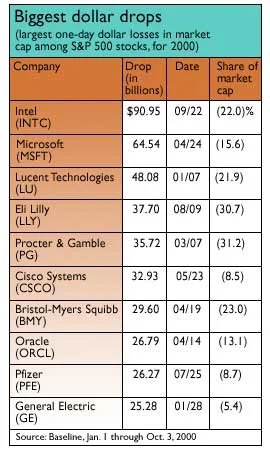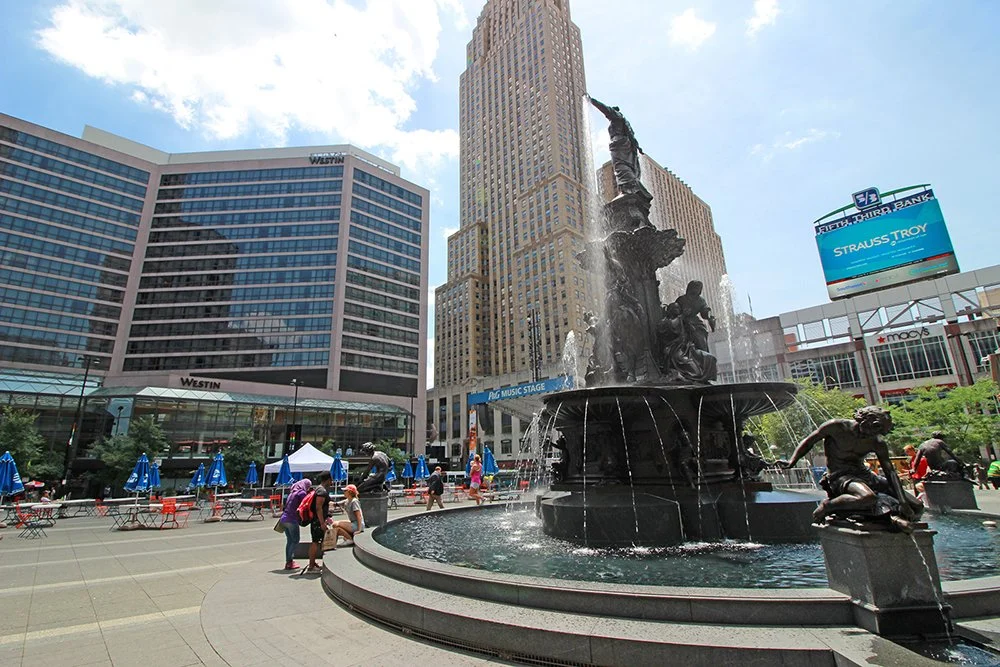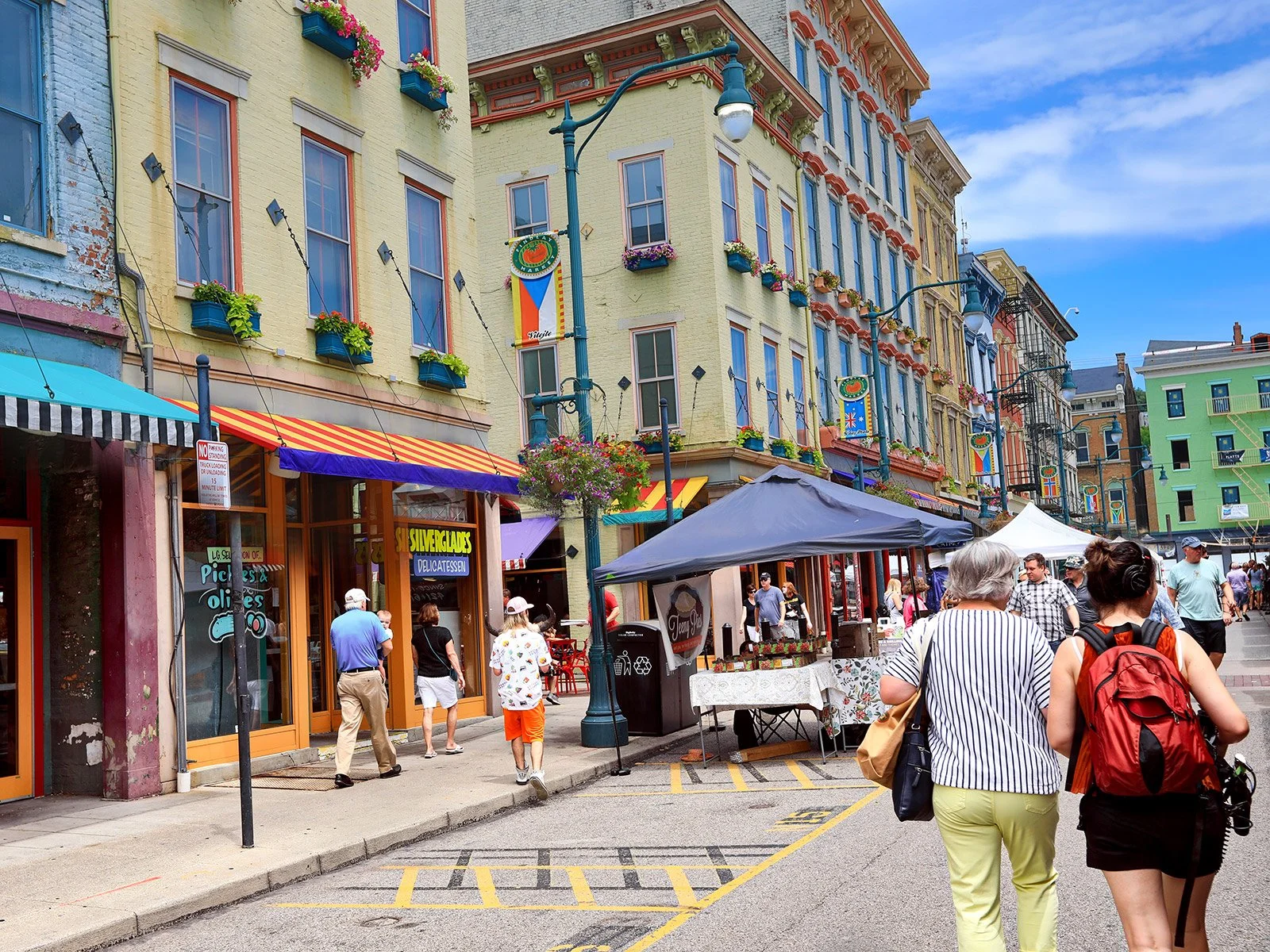3CDC: Transforming Cincinnati
AG Lafley, author and founder Leading to Win, has led a number of nonprofit organizations from Cincinnati Center City Development Corporation (3CDC) to The Bay Park Conservancy, providing him with a great understanding of the dynamic between business, leadership and nonprofit strategy. From roles and responsibilities to best practices and leadership tips, AG shares over 50 years of his experience with you.
We were doubly challenged in 2000 and 2001. P&G missed its earnings goal for fiscal year 2000, and the company’s stock price plummeted 30% in calendar year 2000—a bad year for big public company share prices. The company was in a crisis… mostly of its own making.
Some of the largest companies whose shares prices plummeted in year 2000.
Then, when we were just beginning to dig out of company problems, the City of Cincinnati— our current headquarter and home city where the company was founded by William Procter and James Gamble in 1837— was also plunged into crisis by the unfortunate shooting of a young black teenager by a young white police officer. When understandable unrest ensued, and Mayor Charlie Luken was left with no other choice than to impose a curfew and other restrictions that disrupted city life, I was left with no other choice than to get involved in the city in which I lived, worked and cared about. Fortunately, the mayor, business and community leaders all came together in a coalition that focused on changing the city, beginning with the central business district and adjacent neighborhoods.
Where to Play
Our strategy, where to play, was to focus on the core by beginning with Fountain Square— the center of the city since being founded in the 1790s— and then work block by block throughout the central business district. The work spanned from the south to the Ohio River, five blocks from Fountain Square, to the north, including the troubled Over-the-Rhine District, six blocks from Fountain Square.
How to Win
Our how to win strategy, unique and innovative at the time, was to form a private, nonprofit development and finance organization focused on revitalizing Cincinnati’s downtown urban core through a partnership with the City of Cincinnati and the Cincinnati’s corporate community.
The name of the private nonprofit? Cincinnati Center City Development Corporation— 3CDC. Thirty business and community leaders joined the 3CDC board to oversee the strategy and planning for revitalization and, importantly, contribute annually to operating costs of 3CDC and invest periodically in city redevelopment projects.
Fountain Square in Cincinnati, Ohio
What 3CDC did that could not have been done by any other entity was attract the right resources: talent of all kinds and the funding needed to sustain the revitalization strategy for decades until the city was finally transformed and fundamentally changed in a way that made Cincinnati an attractive place to live and work, bringing together the community.
3CDC raised a lot of money from different types of donors. Businesses who wanted to invest in their home city to attract customers, employees and investors donated to the cause. In addition, government at all levels — city, county, state and federal — had a vested interest and a stake in the revitalization of cities and communities. Foundations and private philanthropists, too, believed in and donated to some specific projects like the creation and revitalization of public parks, the revitalization of arts, cultural and educational institutions.
3CDC attracted a lot of talent, beyond funders and investors, including capable and experienced developers, project managers, creative financiers and importantly, the team needed to activate, program and operate civic places and spaces once they were developed or redeveloped.
No hire was more important than Steve Leeper, who had led the redevelopment of Pittsburgh’s Riverfront. Steve was the CEO of 3CDC at inception in 2003, and still is today. In these 18 years, 3CDC has managed an investment of nearly $2 billion in 200 building or civic space transformations, including Fountain Square, Washington Park, Riverfront Park, Memorial Hall, Music Hall and many more. Over-the-Rhine, which in 2009 was called the most dangerous neighborhood in America, has now been described as having the look and feel of Greenwich Village (2020).
Over-the-Rhine District, Cincinnati, OH.
In less than 20 years, what began as fixing specific problems in specific areas in the Central Business District, has turned into an incredible transformation of not only a city, but also a community.
In Cincinnati, a crisis turned into an opportunity. Fixing problems one at a time ended up significantly transforming the physical infrastructure of the city which, in turn, created more attractive commercial and residential opportunities.
Most importantly, this transformation of a city enabled the transformation of a community: the coming together of all of the diverse elements that make up the residents and workforce of Cincinnati in gathering places that are open, accessible and welcoming to everyone.
3CDC is a great example of the application of Leading to Win (LTW) leadership and Playing to Win (PTW) strategy, innovation and proven management practices to transformative civic and community initiatives.
This article wraps up our Nonprofit November series. Tune in every Thursday starting December 6th to learn all about Freelancing, and learn all about how you can to boost and maintain the success of your freelance business.



